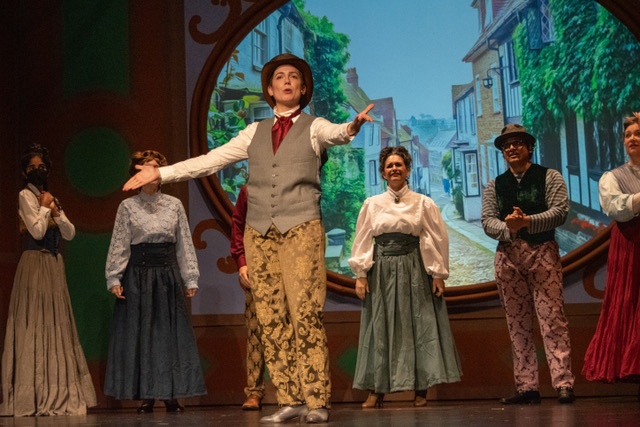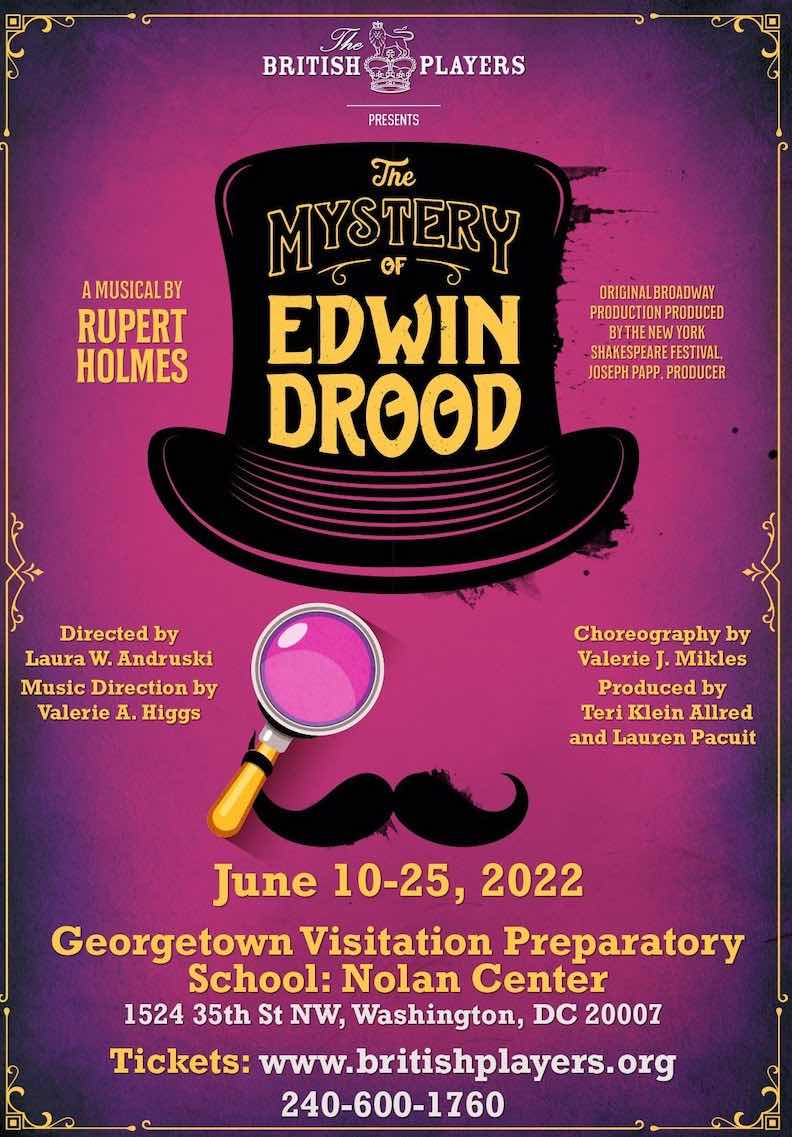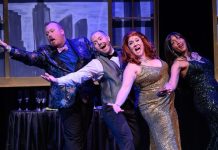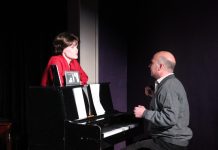Whether you’re a fan of whodunits like Knives Out and Agatha Christie novels or are a Charles Dickens enthusiast, the British Players’ production of The Mystery of Edwin Drood is not to be missed. Based on the unfinished novel of the same name and adapted into a musical by Rupert Holmes (book, music, lyrics, orchestrations), this family-friendly production turned choose-your-own-adventure musical takes a creative approach: at the place in this adaptation (Act II) where the late Dickens put down his pen forever, the audience gets to vote on the ultimate conclusion to the show. Who killed Edwin Drood? Who in the cast is disguised as the investigator? And which two characters will find romance? Only you can decide. This leads to endless possibilities sure to keep all attendees guessing until the musical’s final notes.

The show follows Edwin Drood and his dear friend, Rosa Bud. As Drood and Rosa Bud have been betrothed since childhood, they are unsure if they see each other as lovers or friends. Throughout the show, Drood contends with several rivals for Rosa Bud’s affections including Neville from Ceylon (aka Sri Lanka) and Drood’s uncle, Jasper. Jasper, who also serves as Rosa Bud’s music teacher, is a textbook villain and frequent customer of Princess Puffer’s opium den. Throughout the show, Neville’s twin sister, Helena, becomes dear friends with Rosa Bud and will do anything to save her. Meanwhile, the Reverend Crisparkle has long-harbored affections for Rosa Bud’s mother, the playwright Bazzard awaits his turn in the limelight for once, and the undertaker Durdles knows far too much about the matters of death in the village of Cloisterham. When Drood is murdered, all of the above become suspects. But who do you think did it?
Laura W. Andruski’s phenomenal direction artfully collapses the fourth wall of the play-within-a-play conceptualized by Holmes. The show’s players, who are really music hall performers putting on a production of Dickens’ The Mystery of Edwin Drood, meander around and have genuine conversations with the audience both during the beginning of the show and throughout the intermission. Though one might expect such complexities to create confusion, Andruski’s skillful staging clarifies when the music hall performers are playing themselves and when they are putting on their production of Drood.
Music Director Valerie Higgs creates a wonderful tonal landscape. Higgs also faces the challenge of simultaneously conducting and playing in the small but mighty six-piece orchestra reduced from the original (Audrey Chang, Violin; Mark Allred, Trumpet; Tony Aragon, Bass; Mayumi Baker, Drums/Percussion; Steve Ward, Trombone; Valerie Higgs, Conductor / Keyboard I; and Lynn C. Kaplan, Keyboard II).
Valerie Mikles’ jaunty choreography serves as a highlight of the evening. In “Don’t Quit While You’re Ahead,” the cast wield parasols and form a moving kickline with interweaving and interlocking parts.

Justine Crimans’ costume design is eye-catching. The marriage between her thoughtful costumes, Stephen Walsh’s astounding wig design, and Cathy Dunn’s flawless make-up design lends to a visually pleasing performance. As the cast starts the show scattered among the audience, this is what the eye is drawn to first. I knew when I saw the entire ensemble that I was in for a treat of a night.
Matt Mills’ sound design creates the perfect sonic blend. A jack-of-all-trades, Mills also serves as the musical’s projection designer. The lighting is spectacularly designed by Steve Deming. Robert Leembruggen (set and scenic design) and Mike Lewis (set design) craft an inviting musical hall, which features an oval projection screen, theatrically red curtains, and brightly colored, painted stained glass windows. Leemrbuggen’s scenic pieces such as the small front of a train that choo-choos onto the stage at the top of Act II are well constructed.
Some minor critiques: the Nolan venue’s limitations occasionally cause the projection screen to wobble. The playing space is also difficult to fill and is at its best when either the scenic pieces and/or full company are brought on stage. In moments with just a few characters, the stage could sometimes feel slightly sparse. Additionally, as the audience is seated on the same level, one of the follow spots is intensely bright during Puffer’s exit through the center aisle, but only briefly. However, the production team, and particularly the stage management team (helmed by Aaron Skolnik), should be lauded for a fantastic production full of seamless transitions and continuous action.
Another challenge Drood typically presents is in its casting. I also enjoyed the new life they brought to their interpretation of the twins Neville and Helena Landless. In the Holmes musical, the original and revival casts included white music hall players pretending to be Sri Lankan. In this production, we have the privilege of seeing Niranjali Amerasinghe (Helena Landless / Miss Janet Conover), who is actually from Sri Lanka, and Shakil Azizi (Neville Landless / Mr. Victor Grinstead), an actor of color, in these roles. These are characters that require no further explanation because, contrary to popular belief, people of color did in fact exist during the 19th century. There are occasional moments in the show where the twins are “purposefully played to stereotype,” but that is due to issues within the musical’s book itself and are not to be confused nor conflated with Amerasinghe’s and Azizi’s phenomenal interpretations.

Niranjali Amerasinghe has a beautifully clear and resonant alto voice and her mesmerizing movements and quick thinking make her an instant crowd favorite. Shakil Azizi, or should I say, the eyebrow king, serves genius facial expressions, provides well-paced comedic timing that never strays too far into farce, and garners much full-belied laughter.
Mattie Cohan (Mayor Thomas Sapsea / Mr. Wm. Cartwright, Chairman) serves as a necessary narrator throughout the evening. An engaging actor and singer, she juggles multiple roles, and she does it in pants! Douglas Richesson (John Jasper / Mr. Clive Paget) possesses an expansive tenor range and strikes just the right balance between portraying a villain and having a natural charisma that makes the audience love to hate him.
Mel Gumina (Alice Nutting / Edwin Drood) astonishes in this leading role. Gumina’s strong and consistent belt provides riveting lows and thrilling highs, and she is equally convincing in both a dress and in trousers. Shelby Young (Rosa Bud / Miss Deirdre) is not your average ingenue. Not only is she a classically trained soprano with a breathtakingly chilling voice that soars over the ensemble in just the right places, but she also possesses serious acting chops. Gumina and Young’s balanced harmonies blend gorgeously in their duet “Perfect Strangers.”
Chuck McCarter (Rev. Crisparkle / Mr. Cedric Moncrieffe) is a true theater veteran. McCarter, who has played this role before, is equally charming in both song and character, and gives a performance that is full of heart. Meghan Williams Elkins steals the show as Princess Puffer / Miss Angela Prysock with her powerful vocal finesse.
Andrew Harasty (Durdles / Mr. Nick Cricker) and Rohan Basuthakur (Deputy / Mr. Nick Cricker Jr.) are a dynamic duo on the stage, and Tom Barylski’s (Bazzard / Mr. Phillip Bax) voice is remarkably sweet in “Never the Luck!”
Members of the featured ensemble provide an energetic showing. Sam Kuhr (Mr. James Throttle / Stage Manager), Natasha Scott and Allison Mollenkamp (“Moonfall Quartet”), and Mark Crimans and Liz Mulligan (featured dancers in “Don’t Quit While You’re Ahead”) all give stellar performances.
In a time where many of our interactions over the past few years have been virtual or from a distance, the British Players’ production of The Mystery of Edwin Drood reminds us what it means to have intimate conversations and feel included. When performing Drood, smaller companies often fix or limit the ending ahead of time, but not the British Players. When attending this show, look carefully as you exit the venue: The British Players proudly showcase the “Writing on the Wall” with a board that details which endings previous audiences have chosen. This makes you want to come back, again and again, to see which other characters steal the spotlight next. The British Players competently prove that they can handle the impromptu nature of live theater where the show must go on. And go on it did.
Running Time: Approximately three hours including a 15-minute intermission.
The Mystery of Edwin Drood plays through June 25, 2022, presented by the British Players performing at Georgetown Visitation Preparatory School: Nolan Center, 1524 35th Street NW, Washington, DC. Tickets ($28, adults; $15, children under 12) are available for purchase online.
COVID Safety: The British Players do not require patrons to present a vaccine card or wear masks during the performance.
SEE ALSO:
British Players to open ‘the little play that could,’ ‘The Mystery of Edwin Drood’





